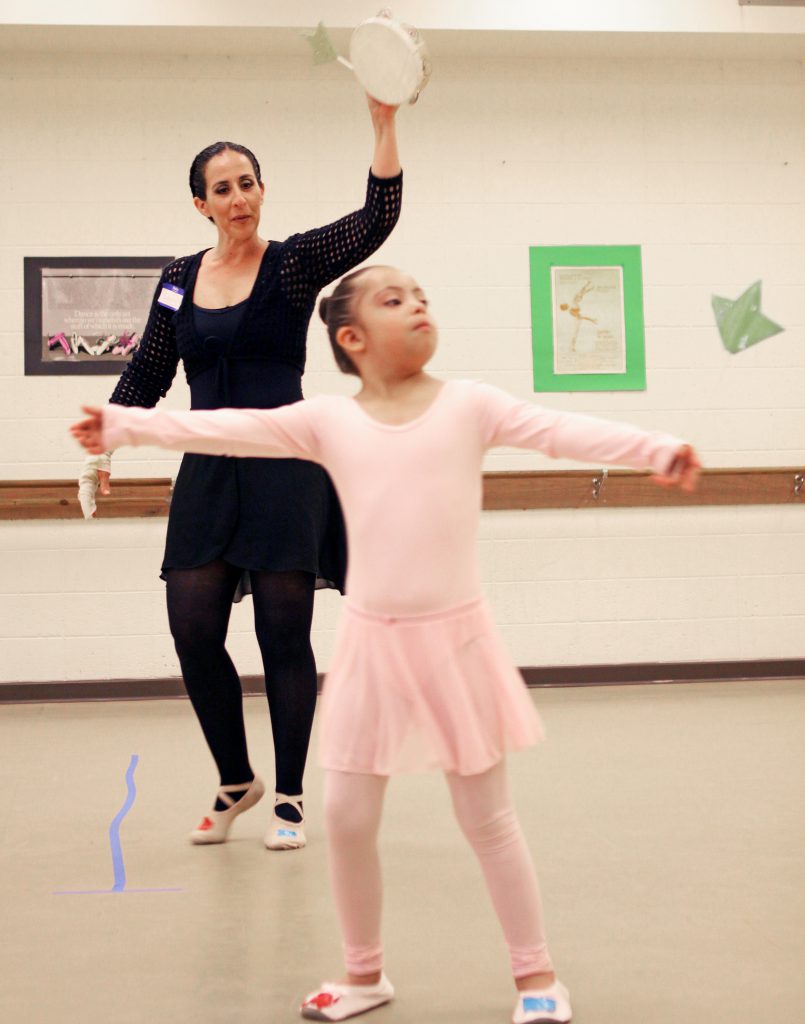Originally published October 10, 2014
By Daniel Perez
UTEP News Service
Laura Escobar has been dancing for most of her 41 years. The senior dance major has drawn on her passion for ballet to create a unique research program at The University of Texas at El Paso that she hopes will benefit children with Down syndrome.
Escobar’s senior capstone project is studying how light, graceful movements can improve the health and general quality of life of children with the genetic condition that affects approximately 1 in 800 children and causes varying degrees of intellectual and physical disabilities and other medical issues.

She started the eight-week fall course three weeks ago with three volunteer assistants and six students whose families belong to the Down Syndrome Association of El Paso, but the planning started about three years ago.
The Juárez native was auditing dance classes at studios around El Paso as part of an assignment. On one occasion she met a mother with three daughters including one with Down syndrome. Two were part of the class, but the mother kept the other one out, saying she was “too energetic,” but that daughter danced the whole class in the lobby.
“I thought that wasn’t fair,” Escobar said before a recent class. “It put a bug in my ear.”
The instructor, who earned a bachelor’s degree in business management from UTEP in 1996, decided to combine her love of dance, organizational skills, entrepreneurial spirit and interest in serving children with special needs for her senior project. The married mother of three – ages 8, 6 and 3 – began to research the disorder to see how ballet could be used to benefit participants physically, socially and mentally.
In class, Escobar used a tambourine to mark time and draw attention to her requests made in English and Spanish. Her six students, each approximately 7 years old and in ballet attire, were encouraged to participate. She kept things moving to accommodate the short attention spans. The volunteer assistants, two physical therapists and the teenage older sister of a student, spent most of their time corralling and cajoling the other students to take part. Even the shyest classmates involved themselves occasionally.
“Our immediate goal is to catch their attention,” Escobar said. Her class meets at 4:30 p.m. Tuesdays in Room 201 in the Fox Fine Arts Center. “We’re building a foundation here.”
The parents who patiently waited outside the studio recounted stories of their children marking the days between classes and striking ballet poses such as arms overhead in an oval shape when they see their ballet clothes.
Filiberto Garcia, father of 7-year-old Isabella, said he appreciated the efforts by Escobar and the University to reach out to children with disabilities. He said his daughter is excited to attend class and to dance with other children.
“This project is amazing,” said Garcia, a 1997 UTEP alumnus who earned his bachelor’s in business management and owns an El Paso trucking company. “It’s hard to find something for (Isabella). We get turned away. It’s difficult to have your kid rejected.”
Escobar’s research showed efforts such as hers were part of a small, but growing national movement. Some of the bigger, established programs are Boston Ballet’s Adaptive Dance and Free 2 Be Me Dance (F2BMD) in Los Angeles. She has spoken with Colleen Perry, a licensed marriage and family therapist who founded and leads F2BMD.
Perry, who started her program in 2009, said she told Escobar the path to success is through connecting with the students and tailoring the exercise to their needs. These programs give students something fun beyond their weekly therapy sessions.
“There is a need for this,” said Perry, who is expanding her program into Orange County. “What we bring is the opportunity to move your body for the joy of it. There is a feeling of love, respect and acceptance for the dancer. It gives them an identity.”
Lisa Smith, head of UTEP’s dance program, guided and encouraged Escobar through the process and said her department’s leadership is ecstatic with the program and looks forward to it becoming interdisciplinary with input from faculty in the colleges of Education and Health Sciences.
“This is a whole new area to explore,” she said.
Adriana Dominguez, Ph.D., senior lecturer of theatre arts, has helped Escobar with the class logistics and said the effort answers a special need.
“The University is supposed to serve the community and this is a fantastic example of it,” Dominguez said.
Anyone interested in volunteering to help Escobar during her one-hour class are encouraged to contact her at lescobar2@miners.utep.edu.